DEPARTMENT OF CRAFTS
Outline
Established in 1889 as the Art-Crafts Course (including metal and Urushi works) of the Tokyo Arts School, the Department of Crafts was reorganized in 1975 into an institution offering both basic and specialized knowledge in the following areas of study: Metal Carving, Metal Hammering, Metal Casting, Urushi-Art (Japanese Lacquer), Ceramics, and Textile Arts. The Woodworking and Glass courses were established in 1995 and 2005, respectively.
The undergraduate program consists of seven courses, while the graduate program comprises 14 studios. The system encourages students to work in the field of their choice, always seeking to encourage their talent in an environment that stresses creative freedom.
Both art and its role change over time. The spirit and techniques of crafts, based on a historical tradition, correspond to one of the most familiar arts, steadily brightening people’s lives throughout the times. Craft objects made with carefully selected materials and drawing on traditional techniques offer inspiration in our daily lives.
The Department of Crafts seeks to train artists capable of assimilating the sets of values and the technologies of a contemporary society that continues to fragment and diversify through instruction in basic techniques that permit each individual to develop his or her talents. We seek to develop creativity and practical skills by offering personalized instruction through a small group policy that focuses on the creation of craft objects.
The Department of Crafts also works to enhance international exchange and regional cooperation through social and research activities imbued with the spirit of the department.
Basic Craft
Overview
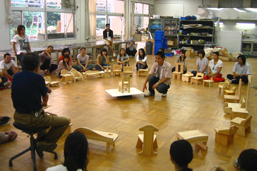 In the Basic Craft Course, students acquire the basic knowledge required for various specializations.
In the Basic Craft Course, students acquire the basic knowledge required for various specializations.
First-year students are trained at the Toride campus. To instill a broader outlook and inspire general creativity, students participate not just in basic craft programs, but in programs organized by lecturers from other departments.
Making Happi (Japanese festival clothing) and a huge Mikoshi (a portable shrine) for “Geisai” (school festival in autumn) constitutes one of the most significant projects for first-year students. First-year students from the departments of Art and Music join hands to create Happi and Mikoshi for this festival. Through this cooperation, students gain a special understanding, experience, and relationships which they otherwise would not from working individually.
From the second-year, students are trained at the Ueno campus. Faculty members in each field instruct students in the specific materials and techniques used in different fields. Students split up from the second semester to concentrate in one specialty of their choice.
Policy
Curriculum Policy
Faculty: The acquisition of the basic crafts practices and research related to the fine arts is conducted, and expression skills are nurtured. Individuals who can comprehensively contribute to society as excellent craftspersons are nurtured, and based on acquired technical skills, education is extensively developed.
In the first year and the first term of the second year, the fundamental expression skills and creative sensibilities related to the domain of basic crafts are nurtured. From the second term of the second year, students explore their individual expression skills through the acquisition of technical expertise based on the sub-domains in each department.
Master: The goal is to foster the acquisition of individualized creative expression in crafts and advance creative research in each specialized field while nurturing individuals who can widely disseminate their art to society.
Doctor: The objective is for students who have acquired the Master’s degree to further expand their knowledge of advanced specialized research and establish creative expression and theories in crafts from an international perspective.
Diploma Policy
Faculty: The Bachelor’s degree is awarded once the specified class credits have been acquired, the curriculum policy has been fulfilled, and after the final assessment has been conducted for the graduation work.
Master: The Master’s degree is awarded once research with the creative work is advanced in conjunction with the individual research themes under the guidance of a supervisor in the concerned research field and teaching staff in related fields and the final assessment has been conducted for the completed creative work.
Doctor: The doctoral degree is awarded once the Thesis Review Committee comprising the supervisor in the concerned research field and the faculty in related fields has conducted a review and assessment of the creative work and dissertation.
Curriculum
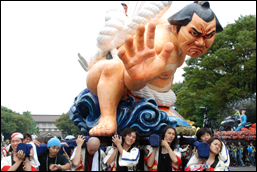 *The first year:
*The first year:
In learning various aspects of art through the following programs, students gain basic creativity, knowledge, and skills while learning expressive techniques and a familiarity with values that apply in other fields of art.
– Free expression program (by instructors from the Basic Craft Course)
– Painting program (by instructors from the Oil Painting Course)
– Woodworking program
– Modeling program (by instructors from the Department of Sculpture)
– Painting program (by instructors from the Japanese Painting Course)
– Glass art program
– Craft creativity theory – Lectures on the essence of the craft (taught by all professors from each subdomain of the Department of Crafts)
*The second year:
Students choose their areas of specialization at the historic Ueno campus, surrounded by teachers and peers.
In the first semester, students choose and create works in three of the following six specialties: Metal Carving, Metal Hammering, Metal Casting, Urushi-Art (Japanese Lacquer), Ceramics, and Textile Arts.
In the second semester, students receive instruction in their selected area of specialization through the basic practical programs.
Metal Carving
Department/course summary
 The Metal Carving Course has left its mark on university history since its establishment as a metalworking course at the founding in 1887 of the Tokyo Fine Arts School, the predecessor of the Tokyo Geijutsu Daigaku Faculty of Fine Arts. Its first professor, Natsuo Kano, was named a Teishitsugigein by the Emperor in honor of his achievements, the highest honor in the world of arts and crafts at the time, granting him Imperial protection. Shomin Umino, also awarded Teishitsugigein status and named professor, made available to the public a large number of traditional Japanese metal-carving techniques accumulated since the Muromachi Period and jealously guarded up to that time, systematizing these techniques as part of the school’s program of instruction. He left behind numerous metal plates prepared for instructional purposes, which even today are used to instruct students in classes on basic techniques. These metal-carving techniques, of which the course can be proud, have been passed down continually over time, ceaselessly leading to new expression and new creation and helping train superior metal carvers by emphasizing the possibilities inherent in materials.
The Metal Carving Course has left its mark on university history since its establishment as a metalworking course at the founding in 1887 of the Tokyo Fine Arts School, the predecessor of the Tokyo Geijutsu Daigaku Faculty of Fine Arts. Its first professor, Natsuo Kano, was named a Teishitsugigein by the Emperor in honor of his achievements, the highest honor in the world of arts and crafts at the time, granting him Imperial protection. Shomin Umino, also awarded Teishitsugigein status and named professor, made available to the public a large number of traditional Japanese metal-carving techniques accumulated since the Muromachi Period and jealously guarded up to that time, systematizing these techniques as part of the school’s program of instruction. He left behind numerous metal plates prepared for instructional purposes, which even today are used to instruct students in classes on basic techniques. These metal-carving techniques, of which the course can be proud, have been passed down continually over time, ceaselessly leading to new expression and new creation and helping train superior metal carvers by emphasizing the possibilities inherent in materials.
Beginning with preparation of tools such as cold chisels, the course examines traditional techniques such as engraving, chasing, inlaying, binding, cloisonné, and metal coloring; addresses basic issues to deepen student understanding of materials; and provides highly specialized guidance in areas such as metal-carving techniques and jewelry. This instruction is informed by an awareness of current trends in living space interiors. Based on these activities, students gradually acquire advanced knowledge and skills, creating works while learning about what forms creative expression can take and how to express themselves in their works, examining genres such as personal accessories and objets d’art. The program develops graduates capable of thriving in the process of creating new types of individuality, armed with powerful expressive techniques.
Curriculum
Curriculum (undergraduate education)
 The courses of instruction for undergraduate education seek to develop graduates capable of thriving by creating a wide range of works for today’s society and living spaces, from traditional crafts through three-dimensional works, jewelry, and other articles. In addition to learning various metal-carving techniques, traditional and otherwise, by pursuing assigned works, students also gain a comprehensive knowledge of various methods for handling metal with sensitivity, including creating new tools, when necessary, as well as adding to a growing store of experience with various materials.
The courses of instruction for undergraduate education seek to develop graduates capable of thriving by creating a wide range of works for today’s society and living spaces, from traditional crafts through three-dimensional works, jewelry, and other articles. In addition to learning various metal-carving techniques, traditional and otherwise, by pursuing assigned works, students also gain a comprehensive knowledge of various methods for handling metal with sensitivity, including creating new tools, when necessary, as well as adding to a growing store of experience with various materials.
Each student is guided by the entire program faculty in creating assigned works as well as exploratory projects and the thesis project, to determine how best to develop the expressive abilities of each student amid a wealth of possibilities. In addition, the program seeks to build an educational structure for communicating with the world through intensive lectures in specialized areas and through international exchange, including foreign-exchange programs and visits from guest artists invited from overseas.
*Second semester of the second year
Students who choose metal carving begin with tools creation, creating cold chisels for chasing, engraving, and inlaying (flat and relief), among other tasks. Guidance is provided by assigning works for each tool and application, using metal plates.
*Third year
In a continuation of the educational program in the second semester of the second year, students learn the basic techniques of binding and inlaying (texture and openwork), together with various metal-coloring techniques, to create works such as boxes and frames. Intensive lectures address specific genres such as personal accessories. Students create exploratory projects in genres such as objets d’art and crafts.
*Fourth year
Fourth-year students study various techniques such as cloisonné. They also receive guidance on developing high-quality thesis projects through testing and growth focusing on specific interests, techniques, and processes in the creation of exploratory projects.
Curriculum (graduate education and research)
Each student in the master’s degree program pursues a course of study and active creation based on his or her own specific interests. Although the program is divided administratively into two separate studios, guidance is provided by the entire metal-carving studio faculty, as students pursue more advanced exploratory projects and creative works. In addition, students are expected to work proactively in presenting their works. Concurrent activities include interactions with traditional craftspeople and collaborative efforts to develop new products.
First-year students are encouraged to develop a deeper understanding of Japanese metal-carving techniques and knowledge. Students are assigned carving and embossing projects based on the techniques and resources traditionally used in the metal-carving studio. As their experience broadens with hands-on practice in areas such as precision casting, students proceed with the creation of three separate exploratory projects.
In the second year, students increase their levels of specialization in accordance with their own specific interests and advance to create two separate exploratory projects and their master’s project.
In doctoral programs, each student identifies and advances through his or her own research themes, based on the assumption that he or she possesses in-depth knowledge of and experience with metal-carving techniques and materials. Students develop their own creative theories and perspectives, gain an even familiarity with and understanding of techniques, materials, and expression, and create exploratory projects and creative works. The guidance structure includes both head and deputy instructors in metal-carving studios and deputy instructors from other departments, who provide in-studio guidance; other instructors also provide guidance with thesis work.
Other information
*International exchange (past five years)
Lecture by Dr. Christianne Weber-Stöber, Managing Director of the Association for Goldsmiths’ Art in Germany (2003 academic year)
Lecture by Cornelia Holzach, Director of the Jewelry Museum of Pforzheim, Germany (2007 academic year)
Guest lecture and workshop by jewelry artist Thorkild Thøgersen of Copenhagen, Denmark, invited with aid from the Japan Foundation (2008 academic year)
*Acceptance of exchange students (past five years)
Student from China (research student, 2003 academic year)
Student from South Korea (graduate student, 2004 – 2005 academic years)
Student from South Korea (research student, 2005 academic year)
Exchange student from Germany (second semester of 2007 – first semester of 2008 academic years)
Student from South Korea (doctoral student, beginning in 2008 academic year)
Exchange student from South Korea (second semester of 2008 academic year)
*Student prospects after graduation
Graduates have gone on to become jewelry artists, craftspeople, metalworking artists, cloisonné artists, jewelry designers, craft designers, cloisonné designers, interior designers, university instructors, directors of metal-carving schools, instructors at metal-carving schools, jewelry-company managers, Mint Bureau employees, etc.
Metal Hammering
Department/course summary
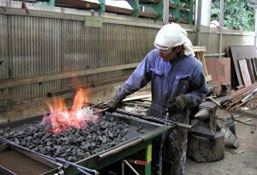 The Metal Hammering Course originated in 1895 with the metal-hammering department, established during the expansion of the arts and crafts department in the Tokyo Fine Arts School.
The Metal Hammering Course originated in 1895 with the metal-hammering department, established during the expansion of the arts and crafts department in the Tokyo Fine Arts School.
In the Metal Hammering Course, students familiarize themselves with techniques ranging from traditional to modern metalworking, based primarily on processes such as plastic working of metal and molding via cutting. The course also seeks to foster student capacity to express themselves freely using metal through the creation of exploratory projects.
Following graduation, students use the wealth of creativity and sensitivity established through their creative studies in the Metal Hammering Course to thrive in creative spheres as artists, as well as in various fields such as architectural and spatial environment, design, and education.
Curriculum
Curriculum (undergraduate education)
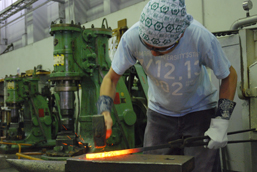 For undergraduates, the metal-hammering curriculum begins in the second semester of the second year. Students begin by preparing their tools (metal hammers and guides), then create copper vases through spinning, a basic metal hammering technique, to get their first hands-on experience.
For undergraduates, the metal-hammering curriculum begins in the second semester of the second year. Students begin by preparing their tools (metal hammers and guides), then create copper vases through spinning, a basic metal hammering technique, to get their first hands-on experience.
In the first semester of the third year of the undergraduate program, students gain practical experience with welding, joining, and forging as well as metalworking (using lathes, milling machines, and other equipment) and spinning. In the second semester, they create works from copper using metal spinning. Through this experience, they learn basic metal-hammering techniques and metalworking. In the first semester of the fourth year, students pursue studies based on their own themes. In the second semester, they begin work on their thesis projects.
Curriculum (graduate education and research)
In the graduate program, students undergo practical metalworking training in the Toride metalworking studio and precision casting training in the casting studio, pursuing more in-depth metal knowledge and skills. They begin working on their master’s degree project after gaining familiarity with a wide range of expressive skills.
Metal Casting
Department/course summary
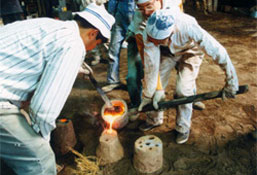 The Metal Casting Department was established in 1892 within the arts and crafts department at the Tokyo Fine Arts School. Under instructors Sessei Okazaki and Jo’un Oshima, department graduates, including Shinobu Tsuda, Hotsuma Katori, Toyochika Takamura, and Haruji Naito, became leaders in the modern craft movement. With the establishment of Tokyo Geijutsu Daigaku in 1949, the Metal Casting Department became the Metal Casting Course in the Crafts Department. Within the Graduate School of Fine Arts at Tokyo Geijutsu Daigaku, master’s degree and doctoral programs were established in 1963 and 1977, respectively.
The Metal Casting Department was established in 1892 within the arts and crafts department at the Tokyo Fine Arts School. Under instructors Sessei Okazaki and Jo’un Oshima, department graduates, including Shinobu Tsuda, Hotsuma Katori, Toyochika Takamura, and Haruji Naito, became leaders in the modern craft movement. With the establishment of Tokyo Geijutsu Daigaku in 1949, the Metal Casting Department became the Metal Casting Course in the Crafts Department. Within the Graduate School of Fine Arts at Tokyo Geijutsu Daigaku, master’s degree and doctoral programs were established in 1963 and 1977, respectively.
In addition to a succession of instructors including Fubo Maruyama, Haruji Naito, Shugoro Hasuda, Shin’ichi Suzuki, Daiyu Nishi, Masaki Hara, and Keinosuke Totsu, part-time instructors including Jun’ichi Nishimura, Kohei Miyata, and Tadashi Nishimura have taught within the program. Together with education, research, production, and human resource development efforts related to metal casting, the program can point to significant achievements in the study and restoration of cultural assets, including the statue of Masashige Kusunoki (located in the square before the Imperial Palace in Tokyo); the bronze statue of Takamori Saigo (in Tokyo’s Ueno Park); the large doors to the Diet Building; the railings and lampposts of the Nijubashi bridge at the Imperial Palace; and the sacred mirror at Ise Jingu Shrine. Other projects have included the restoration and reproduction of the suien decoration atop the east pagoda of Yakushi-ji Temple; the restoration of the statue of a seated Buddha with two attendants at Yakushi-ji; and a study of the Todai-ji Great Buddha.
Curriculum
Curriculum (undergraduate education)
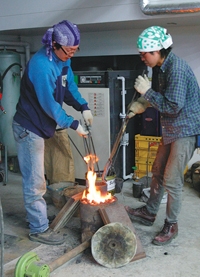 Undergraduate education in the areas covered by the Metal Casting Course proceeds in stages over two and a half years, from the second semester of the second year through the third and fourth years of the program. Students systematically learn techniques and expertise for metal casting, from traditional through the latest metal-casting techniques, through project assignments and self-study, attaining creative skills and refining their sensibilities. The results of diligent daily work and study culminate in student presentation of a thesis project and scholarly research. Students deepen their understanding and discernment of materials and techniques through training in various metal-casting techniques, strengthening general creativity by enhancing skills in developing precise plans and by refining their sensitivity to a broad range of materials, both of which are distinctive characteristics required for metal casting. Attentive training and guidance encourage individual talents to flower while simultaneously teaching students how to work side-by-side to create joint projects.
Undergraduate education in the areas covered by the Metal Casting Course proceeds in stages over two and a half years, from the second semester of the second year through the third and fourth years of the program. Students systematically learn techniques and expertise for metal casting, from traditional through the latest metal-casting techniques, through project assignments and self-study, attaining creative skills and refining their sensibilities. The results of diligent daily work and study culminate in student presentation of a thesis project and scholarly research. Students deepen their understanding and discernment of materials and techniques through training in various metal-casting techniques, strengthening general creativity by enhancing skills in developing precise plans and by refining their sensitivity to a broad range of materials, both of which are distinctive characteristics required for metal casting. Attentive training and guidance encourage individual talents to flower while simultaneously teaching students how to work side-by-side to create joint projects.
Curriculum (graduate education and research)
Each student in the master’s degree program plans research and creation of metal-casting projects based on his or her specific research interests. Support and guidance are provided to advance each student’s creative and research work, drawing on a full range of facilities unparalleled in terms of the size and quality of metal-casting classes, research facilities, and educational environment, including the metal-casting studio in the common studio on the Toride campus. In recent years, joint research activities conducted with local traditional industry have been incorporated into the first-year curriculum to promote greater engagement with society. In doctoral programs, students further refine their areas of specialization and individual sensibilities. Education and guidance target the development of creative concepts rooted in a broad range of fields. Proactive support is provided to help each doctoral program student succeed by establishing guidance structures suited to the nature of each student’s studies.
Other information
*International exchange (past five years)
Experimental exchange course with Daegu University of South Korea (2005 academic year)
*Involvement in the local community (past five years)
Workshops on participation in regional revitalization project for the Kihoku area of Mie Prefecture (2004 – 2007 academic years)
*Acceptance of exchange students (past five years)
Student from Chile (master’s degree – doctoral programs, 2002 – 2007 academic years)
Student from South Korea (master’s degree – doctoral programs, 2002 – 2007 academic years)
Exchange student from South Korea (2008 academic year)
*Student prospects after graduation
Graduates have gone on to become metal-casting artists, metalworking artists, craftspeople, jewelry designers, interior designers, product designers, directors of metal-casting schools, and instructors at universities and other educational institutions.
Urushi-Art (Japanese Lacquer)
Department/course summary
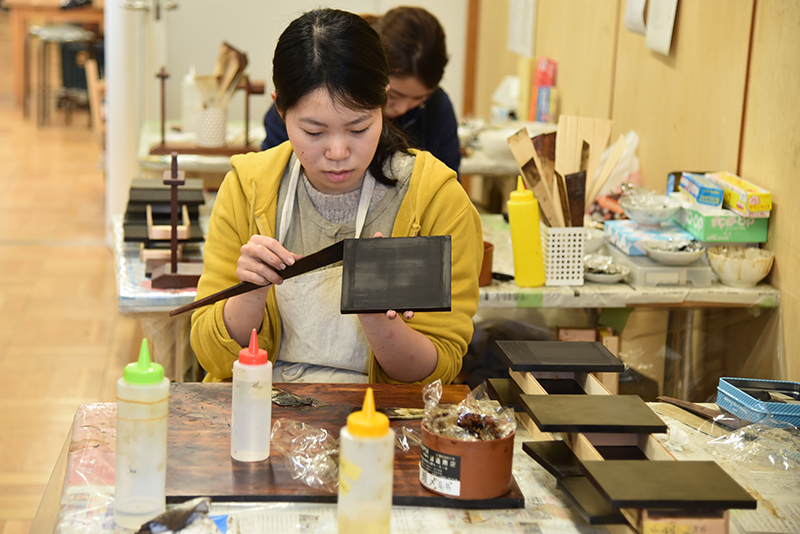 When first established, the Tokyo University of the Arts was known as the Tokyo Art School. Two courses – the Kyuushitsu Course and the Makie Course – were the precursors of what would later become consolidated into the Urushi-Art(Japanese Lacquer) Course.
When first established, the Tokyo University of the Arts was known as the Tokyo Art School. Two courses – the Kyuushitsu Course and the Makie Course – were the precursors of what would later become consolidated into the Urushi-Art(Japanese Lacquer) Course.
Urushi-Art (Japanese Lacquer) was recognized as a major Japanese art form in 19th Century England, as shown by the term “japan” being used at that time to denote fake Makie work. The Tokyo University of the Arts offers the longest history of research and organized education in Urushi-Art (Japanese Lacquer) in the world, and individuals and knowledge from all over the world gather here, underscoring our role as the center of Urushi-Art (Japanese Lacquer).
As the center of Urushi-Art (Japanese Lacquer), we train students and pursue research in various aspects of this natural material, including paint, adhesives, modeling materials, and painting materials. Students also learn to bleed and purify sap from an Urushi tree.
Through the various programs, students learn to use Urushi flexibly, applying techniques for practical applications and for artistic purposes. We train students to become not just Urushi-Artist (Japanese Lacquer Artist), but educators and researchers. A gallery located in the building where the Urushi-Art (Japanese Lacquer) Course is based is used to exhibit both student and faculty work. In addition, the gallery showcases rich collections that highlight materials or techniques of Urushi-Art (Japanese Lacquer).
Explorations of our knowledge of and future directions for Urushi-Art (Japanese Lacquer) often involve collaborative research with universities and government agencies, both here and abroad. These projects often culminate in an exhibition that expresses the results of their work.
Curriculum
Curriculum (undergraduate education)
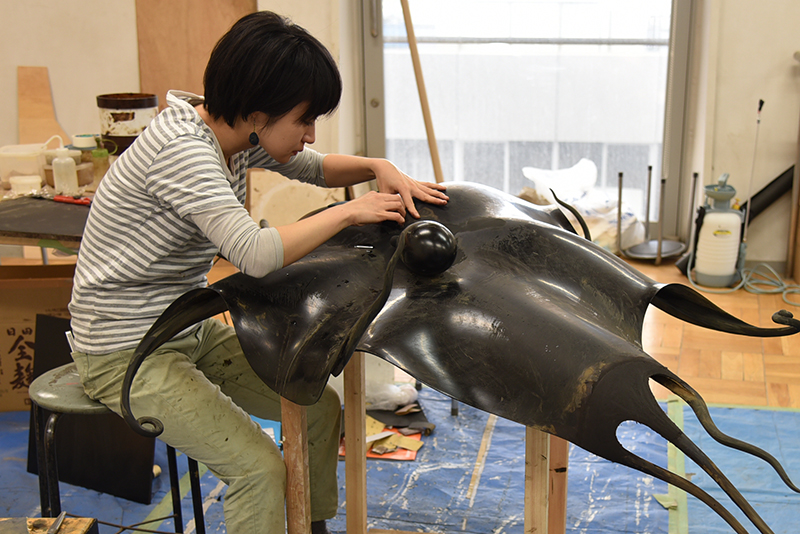 From the second semester of the second year, students begin their journey into the Urushi-Art (Japanese Lacquer) by making their own tools. Only after they have built their tools do they begin to learn basic techniques such as Nuri (painting Urushi), Suriurushi (a technique involving applying Urushi in thin layers) and Roiroage (polishing and making a reflective surface). As part of their classical artwork research project, students get a chance to view artwork at the museum, giving them greater insights into the techniques and cultural background of the work for their essay.
From the second semester of the second year, students begin their journey into the Urushi-Art (Japanese Lacquer) by making their own tools. Only after they have built their tools do they begin to learn basic techniques such as Nuri (painting Urushi), Suriurushi (a technique involving applying Urushi in thin layers) and Roiroage (polishing and making a reflective surface). As part of their classical artwork research project, students get a chance to view artwork at the museum, giving them greater insights into the techniques and cultural background of the work for their essay.
In the first semester of the third-year, through various assignments, students learn different ornamentation techniques, such as Makie (drawing a pattern in Urushi and sprinkling with metal or colored powder) and Raden (mother of pearl inlay technique). In the second semester, students are freed to pursue whatever they wish through the creative research program. Students also learn techniques such as woodworking (wood jointing, woodturning-technique, and wood carving) and Kanshitsu, used to make the objects to which Urushi is applied.
Fourth-year students are taught techniques like Chinkin (Gold-inlay Carving), Choushitu (techniques for carving the Urushi surface) and Kawarinuri (techniques for creating unique textures) in intensive seminars, after which they proceed to graduation work. In exploring and developing their own personal styles, students establish close relationships with the faculty through countless discussions, ensuring that students by graduation are well-acquainted with the more advanced aspects of Urushi history, culture, techniques, and creation.
Curriculum (graduate education and research)
*Master’s degree curriculum
Although students choose their own mentors, all faculty members in the Urushi-Art (Japanese Lacquer) Course contribute to student growth. While all instructors have their own specialties – e.g., modern art or traditional art – rather than encouraging students to follow in their footsteps, teachers seek to nurture student individuality.
Through the history research project, students in the first year examine the roles played by artworks in the history of Urushi-Art (Japanese Lacquer), eventually coming the realization that the artworks they create will also have a place in Urushi-Art (Japanese Lacquer) history.
Based on this outlook, students choose a theme for their research project. Through numerous public exhibitions of their work, students also gain valuable insight into their relationship to society.
Through the comprehensive conservation and restoration research program, students completing their research projects learn not just the theory and ethics of conservation and restoration but practical skills as well.
In the second year, in a culmination of their undergraduate and graduate education, students select a theme that explores their individual potential as artists. We guide students in integrating all the knowledge gained with respect to sensibility, materials, and techniques in the execution of their theme.
*Doctoral curriculum
Under their respective research themes, guided by advisors, students create artwork and produce a formal dissertation. These research themes must account for the place Urushi-Art (Japanese Lacquer) occupies and should occupy in society, both here and abroad. We train students and nurture their potential to become leaders in Urushi-Art (Japanese Lacquer) education both at home and abroad.
Other information
*International Collaborations
As the world’s center for higher education in Urushi-Art (Japanese Lacquer), we organize and run symposiums and interactive exhibitions here and abroad throughout the year, among various other efforts. We invite Urushi-Artists (Japanese Lacquer Artist) from overseas to give lectures or to participate in various seminars to further our understanding of the art.
Our faculty members travel abroad extensively, collaborating with researchers from various nations. Both master’s and doctoral students often ask to take part in this collaborative research, which fosters international exchange at the student level. Such exchange is intended to broaden and deepen student training and education.
Each year, we accept more than three exchange students from countries such as China, Korea, Germany, Myanmar, and Hungary. After graduation, exchange students return home and flourish as teachers at various institutes.
*Career Paths for Urushi-Art (Japanese Lacquer) Students
Although students do go on to become Urushi-Art(Japanese Lacquer) teachers, designers, and conservation researchers, most students aspire to become Urushi-Artists (Japanese Lacquer Artist) and to make their own contributions to this art form.
Ceramics
Department/course summary
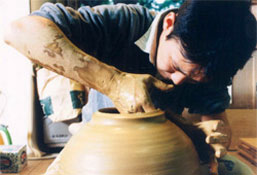 Ceramics education at the university began when Prof. Hajime Kato joined the faculty in 1955. Designated the Ceramics Course in 1963, the program over the years has developed an educational system focusing on traditional crafts. Profs. Yoshimichi Fujimoto and Ko’ichi Tamura were graduates of the design program in the crafts department of the Tokyo Fine Arts School. Prof. Fujimoto, who was once known as an active member of Sodeisha (a Japanese modern art group), later stopped creating avant-garde works and switched to a more traditional style. Prof. Tamura significantly influenced the development of traditional crafts in Japan, among other things by serving as vice-chair of Nihon Kogeikai. Since both professors trained students in practical skills while pursuing their creative work, the program focused on fostering a stronger awareness of tradition and of the level of completeness at which works could be presented to society. Later, Prof. Minami Asano went on to pursue work on the essence of a variety of Japanese ceramic wares and their relationship to Japanese culture, while Prof. Koheiji Miura promoted education that valued the perfectibility and creativity of works to help improve the artistic quality of the program, focusing on the ties between craft and engraving.
Ceramics education at the university began when Prof. Hajime Kato joined the faculty in 1955. Designated the Ceramics Course in 1963, the program over the years has developed an educational system focusing on traditional crafts. Profs. Yoshimichi Fujimoto and Ko’ichi Tamura were graduates of the design program in the crafts department of the Tokyo Fine Arts School. Prof. Fujimoto, who was once known as an active member of Sodeisha (a Japanese modern art group), later stopped creating avant-garde works and switched to a more traditional style. Prof. Tamura significantly influenced the development of traditional crafts in Japan, among other things by serving as vice-chair of Nihon Kogeikai. Since both professors trained students in practical skills while pursuing their creative work, the program focused on fostering a stronger awareness of tradition and of the level of completeness at which works could be presented to society. Later, Prof. Minami Asano went on to pursue work on the essence of a variety of Japanese ceramic wares and their relationship to Japanese culture, while Prof. Koheiji Miura promoted education that valued the perfectibility and creativity of works to help improve the artistic quality of the program, focusing on the ties between craft and engraving.
Today, the program’s educational policy seeks not just to teach an industrial sensibility or practical skills but to improve artistry by encouraging students to express their own ideas in creating articles based on a deeper sense of an artistic mission in areas such as crafts and engraving.
Training in the use of the pottery wheel is a basic program requirement. The program seeks to develop graduates capable of creating ceramic articles by developing an educational environment in which they can create works drawing on a broad range of ceramics techniques, including slipware and firing techniques, and through repeated drills designed to instill skills in creating ceramic objects.
Curriculum
Curriculum (undergraduate education)
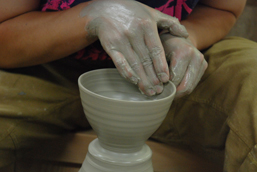 *Second year, undergraduate program
*Second year, undergraduate program
Basic practice in production using the pottery wheel; creating teacups using china clay
Production using plaster molds
*Third year, undergraduate program
Creating large vases and dishes using the pottery wheel and china clay
Decoration using iron painting, dyeing, underglaze; creating three or more works in each category
Molding using plaster molds; using tataki-gihou (beating method) to create dishes
Creating porcelain dishes using the pottery wheel
Creating sake bottles, rice bowls, teacups, plates, small teapots, etc.
Practice using climbing kilns
*Fourth year, undergraduate program
Creating large vases and dishes using the pottery wheel and porcelain clay
Decoration using overglaze, dyeing, underglaze; creating three or more works in each category
Thesis project
Curriculum (graduate education and research)
*First year, master’s degree program
Kiln building practice
Study of firing techniques
Work on assigned research projects
Climbing kiln practice
*Second year, master’s degree program
Creation of assigned research projects
Master’s project
*Doctoral program
Creation of assigned research projects
Other information
*Pursuit of diverse types of creative expression
The program involves exchange courses between graduate students of the Sculpture Department and those of the Crafts Department majoring in ceramics. The program also features an internship system based on an industry-academy joint research venture with ceramics companies.
*Promoting international exchange and training
Through activities including overseas students exchange programs and research trips, the program seeks to broaden student knowledge through practical experience with a wide range of ceramics from an international perspective.
It provides a number of opportunities to communicate traditional styles of Asian ceramics to an international audience.
*Student prospects after graduation
Graduates have gone on to become working artists, university instructors (including part-time instructors), high-school instructors, instructors in ceramics schools, and employees of design and printing companies.
Textile Arts
Department/course summary
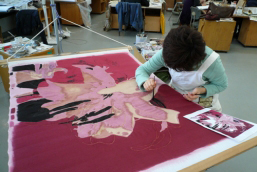 Through the synergies of the unique forms and functions of the national dress, the kimono, and the unique sense of beauty developed within the culture, Japanese textiles have achieved peaks unparalleled anywhere else in the world.
Through the synergies of the unique forms and functions of the national dress, the kimono, and the unique sense of beauty developed within the culture, Japanese textiles have achieved peaks unparalleled anywhere else in the world.
The Textile Arts Course was established in 1967. Since then, it has helped advance new possibilities in textile creation by combining today’s technologies with a grounding in tradition.
The goal of the course is to develop graduates capable of thriving across a broad range of spheres as designers and artists, applying skills based on a deep familiarity with fibers and textiles and high creative capabilities.
Curriculum
Curriculum (undergraduate education)
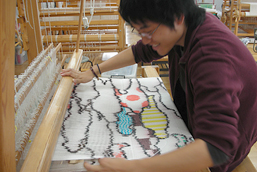 From the second semester of the second year of the program through the third year, students learn the dying techniques of yuzen, stencil dyeing, batik, and screen-printing, as well as tapestry weaving, double weaving, and kasuriori plain-weaving techniques.
From the second semester of the second year of the program through the third year, students learn the dying techniques of yuzen, stencil dyeing, batik, and screen-printing, as well as tapestry weaving, double weaving, and kasuriori plain-weaving techniques.
The program also endeavors to broaden student perspectives by inviting artists and designers from outside the university to give workshops and lectures.
The first semester of the fourth year is intended to help students establish their own creative voice by creating freestyle works based on themes they develop themselves. The program concludes with the completion of a thesis project in the second semester of the fourth year.
Curriculum (graduate education and research)
In the master’s degree program, each student delves deeply into his or her selected specific interest or theme, based on knowledge and techniques learned as an undergraduate, to develop works of even higher quality. Concentrating on dyeing or weaving techniques, students benefit from individual guidance and create works based on themes they choose themselves.
Alongside individual study, students learn about the social impact of the conceptualization, creation, and display of textile arts through participating in social outreach programs in projects planned by their studios.
In doctoral programs, students are expected to achieve even higher levels of specialization and individuality, as they create works and conduct research as working artists, making the meaning of their research clear while examining a single theme from a diverse range of perspectives. Each student receives attentive support to help them complete their degree based on a guidance structure corresponding to the nature of each individual’s research.
Other information
*Acceptance of exchange students
Overseas students are accepted at both the graduate-student and research-student levels. These students receive individual guidance to enable them to develop new possibilities based on the traditions and cultures of their own countries and of Japan.
Each year, the program includes two or three students from countries including China, South Korea, Germany, and Israel.
*Student prospects after graduation
Graduates of the program are active across a wide range of fields, including as textile designers, graphic designers, textile artists, plastic artists, and educators.
Material Arts (Woodworking & Glass)
Woodworking
Department/course summary
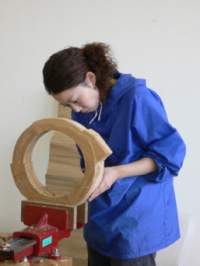 Education in the field of woodworking studies began in the 1995 academic year as the seventh program of the Crafts Department, which is open to only graduate students. The program currently has three instructors: one professor, one research assistant, and one part-time instructor. Additional intensive classes are led by a small number of part-time instructors. In the 2008 academic year, the program enrolled a total of six students in the first and second years of the master’s degree program and one in the doctoral program. While no research students were enrolled last year, the program does accept a small number. The program currently offers only postgraduate education. An undergraduate program is under consideration.
Education in the field of woodworking studies began in the 1995 academic year as the seventh program of the Crafts Department, which is open to only graduate students. The program currently has three instructors: one professor, one research assistant, and one part-time instructor. Additional intensive classes are led by a small number of part-time instructors. In the 2008 academic year, the program enrolled a total of six students in the first and second years of the master’s degree program and one in the doctoral program. While no research students were enrolled last year, the program does accept a small number. The program currently offers only postgraduate education. An undergraduate program is under consideration.
The goals of establishing this course included fostering an in-depth awareness of materials through a broad and in-depth acquisition of knowledge and skills. Students are trained to demonstrate a lively, creative outlook in the world of today while drawing on traditional techniques and concepts, with a focus on wood assembly among the diverse world of woodworking. While the program naturally covers machining, the basic focus is on creation using handheld tools, with the primary emphasis being the encouragement of creativity drawing on traditional skills learned as part of the program.
Curriculum
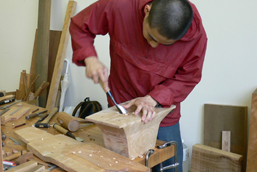 Educational and research structure
Educational and research structure
The program cornerstones for education and research are based on efforts involving the creation of original work, including both assignments from instructors and self-study. The two broad themes are creativity using wood and the study of woodworking techniques and materials. Since even assignments set themes merely as frameworks, significant latitude is given for individual goals and ideas to encourage the production of diverse, freely expressed works.
In the first year of the master’s degree program, students explore topics such as classical techniques and furniture making while creating works based on the nature of each material, with a deep understanding of the lines, facets, and volumes of types of wood and wood materials. At the same time, they learn proper use of hand and machine tools and woodworking safety. While the schedule is undeniably rigorous, all these topics are essential.
A more theoretical perspective characterizes the 10 to 15 annual woodworking seminars, primarily held during the first semester. These seminars tackle topics such as how to approach wood and the connectedness and significance of creative expression and techniques. In the second year, students create two units of themed work and one or more self-directed exploratory projects in the first semester. From the second semester, they devote themselves to master’s thesis projects.
Students in the doctoral program and research students devote themselves entirely to self-directed study and creative work, within a framework that provides support when necessary, depending on the nature of their studies.
*Doctoral program: No specific curriculum is established aside from requirements determined by the graduate school and elective special courses. Students learn based on their own specific individual interests.
*Research students: All aspects of the year-long program are developed as self-learning activities. Student progress is monitored and supported through consultations and adjustments by instructors serving as advisors.
Other information
Graduate students present their works at international exhibitions and take part in international exchange events. Instructors are often asked to participate in exhibitions, special lectures, and symposia. In these ways, the program seeks to promote international exchange.
Some exchange students have enthusiastically tackled the study of Japanese woodworking culture, qualifying for the master’s degree program or as research students in the university’s Woodworking Course following graduation from art schools in South Korea. The program seeks to do its utmost to encourage such efforts to the degree that time and space restrictions permit.
This program was established 14 years ago. Since then, graduates have undertaken a wide range of activities, including remaining in the university as assistants, continuing their studies in the doctoral program or as research students, serving as instructors at art schools, serving as curators at art museums, working at design firms and related businesses, establishing and managing their own studios, and taking part in society through activities as artists. Annual events also include presentations of works by alumni. Some of our students have won strong reputations as woodworking artists and hold exhibits from time to time, including both individual and group exhibitions.
Glass
Department/course summary
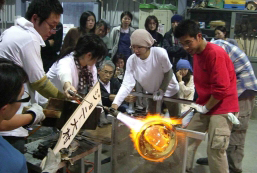 Launched in the graduate school in 2005, the Glass Course examines materials and techniques to train students in plastic-arts activities focusing on glass materials.
Launched in the graduate school in 2005, the Glass Course examines materials and techniques to train students in plastic-arts activities focusing on glass materials.
Applying a wide range of expressive techniques, such as kiln work (pâte de verre, kiln casting, fusing), hot work (glassblowing, hot casting), and cold work (cutting, sandblasting), this course pursues the possibilities of glass materials across a wide range of fields, including crafts, three-dimensional work, and spatial work. It also provides opportunities for investigating connections to other materials such as metal, stone, and wood.
Curriculum
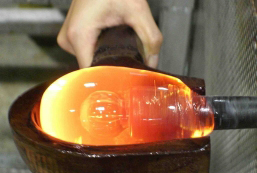 Curriculum (graduate education and research)
Curriculum (graduate education and research)
The glass studio currently has a small educational structure consisting of three instructors, two or three master’s degree students in each of the first and second years of the program, and a small number of doctoral students. It features a range of basic equipment: one melting furnace for hot work, one glory hole, two annealing furnaces, two benches, four electric kiln furnaces, two experimental furnaces, and various machine tools for cold work. Students also create and modify equipment and tools as needed. In addition, the course develops individual curricula to allow each student to deepen understanding of his or her own themes and techniques through detailed tutorials and lectures from guest instructors specially invited from a wide range of fields.
Other information
Glass reflects the cultural and historical backgrounds of Europe, America, and the rest of the world. To take advantage of the global attraction to glass, the course takes a proactive part in efforts such as international exchange with artists and students from overseas, revolving around schools with which the university has concluded international-exchange agreements.





